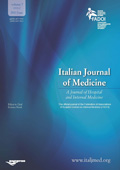Health Organization and Clinical Governance
19 September 2013
Vol. 7 No. 3 (2013)
Management of chronic obstructive pulmonary disease: criteria for an appropriate hospital discharge

Publisher's note
All claims expressed in this article are solely those of the authors and do not necessarily represent those of their affiliated organizations, or those of the publisher, the editors and the reviewers. Any product that may be evaluated in this article or claim that may be made by its manufacturer is not guaranteed or endorsed by the publisher.
All claims expressed in this article are solely those of the authors and do not necessarily represent those of their affiliated organizations, or those of the publisher, the editors and the reviewers. Any product that may be evaluated in this article or claim that may be made by its manufacturer is not guaranteed or endorsed by the publisher.
2307
Views
1047
Downloads
854
HTML






